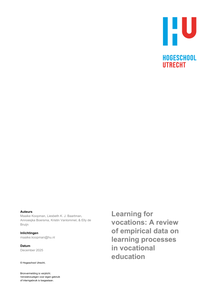Symposium ESWRA - ECSWR 2016: empirical ethics in social work. Objective: ethical aspects of social work (esp. at home) Structure: cooperation of the research group of UAS Utrecht Netherlands with six regional welfare organizations Method: practice based ethics research Focus on professional practice: learning from moral experiences in frontline practice (cf. Van Doorn, 2008) Hybrid approach: combining theoretical resources and professional practice (cf. Banks & Gallagher, 2009) Mixed methods: desk research, interviews, best practice units (BPU), development of ethical tools
DOCUMENT

This article reports on a literature review on empirical research investigating learning for vocations in the context of vocational education. We included 36 studies in which learning for vocations is empirically studied. Learning for vocations is characterised based upon prevalent research traditions in the field and framed from the perspective of vocational education and organised learning practices. This framing and characterisation directed the search terms for the review. Results show empirical data on vocational learning and illustrate how learning processes for the functions of vocational education - vocational identity development, development of a vocational repertoire of actions, and vocational knowledge development - actually take place. The review further shows that, empirical illustrations of learning processes that occur in the context of vocational education and organised learning practices are relatively scarce. The findings can be typified in relation to our theoretical framework in terms of three learning processes, that is learning as a process of (a) belonging, becoming, and being, (b) recontextualization, and (c) negotiation of meaning and sense-making. We argue that more empirical research should be carried out, using the functions of vocational education and the three learning processes to better understand vocational learning.
DOCUMENT

The formation of acrylamide in potato crisps was fitted by empirical mathematical models. Potato slices were fried under the same experimental conditions for different times. Besides the content of precursors in the raw potato slices, acrylamide and water content in the potato crisps were quantified after predetermined times (2-6 min). The temperature developments in the surrounding oil and outer cell layer of the potato slices were monitored, giving more insight in the frying process and making future comparisons between studies possible. The pattern found for the formation of acrylamide, which was similar to earlier studies, was fitted to three empirical models. Statistical methods were used to compare the performance of the models, with the "Logistic-Exponential" and "Empirical" model performing equally well. The obtained model parameters were in the range of earlier reported studies, although this comparison is not unequivocal as the experimental conditions differed between studies. The precision of parameter estimates was problematic; this should be improved by better experimental design. Nevertheless, the approach of this study will make it possible to truly compare acrylamide formation patterns and model parameters in the future, with the ability to develop a tool to predict acrylamide formation in potato crisps.
DOCUMENT
This paper aims to offer a critical reflection on the way Talent Management (TM) is investigated in practice, by addressing the key issues regarding the quality (in terms of rigor and relevance) of academic empirical TM research and therefore the critical scrutiny of TM scholars’ work. We will argue that despite the growth in the quantity, the quality of many empirical TM papers is lagging behind and hindering the progress of the academic field of TM.
DOCUMENT

from the article: "In the Netherlands, housing corporations are increasingly adopting self-service technologies (SSTs) to support affairs their tenants need to arrange. The purpose of the study is to examine the customers’ motivations of using SSTs in the context of the Dutch public housing sector. An empirical investigation is presented based on a sample of 1,209 tenants. Using partial least squares (PLS), the acceptance model of Blut, Wang, and Schoefer is adopted and tested. The results show that especially the need for interaction negatively influence the adoption of SSTs by tenants. Positively, subjective norm and self-efficacy influence the adoption. Furthermore, playfulness negatively influences this adoption. Developers of SSTs should focus on its ulitalitarian function, rather then invest in its playfulness. Moreover, adoption is propelled by the encouragement of others. This can be enhanced by positive word-of mouth and should therefore stimulated."
DOCUMENT

This study examines completion rate for a self-assessment survey designed to assess employees' digital skills levels in the workplace. The aim is to improve data quality by investigating completion of the survey. The study reviews the theoretical background related to self-assessment surveys and completion rate, and explores the influence of survey length and format in survey design on completion rate. The research design and data analysis are described in detail, with a focus on identifying factors that may influence completion rate. Results suggest that survey designers should consider using Likert scales to optimize completion rate and completion time. However, this study did not find a significant increase in completion rate as a result of motivation, which was claimed from the literature. The study concludes with implications for the design and implementation of self-assessment surveys in the workplace, including the importance of reducing length and complexity of survey items and questions.
DOCUMENT

Abstract The emergence of new technologies such as mp3 and music streaming, and the accompanying digital transformation of the music industry, have led to the shift and change of the entire music industry’s value chain. While music is increasingly being consumed through digital channels, the number of empirical studies, particularly in the field of music copyright in the digital music industry, is limited. Every year, rightsholders of musical works, valued 2.5 billion dollars, remain unknown. The objectives of this study are twofold: First to understand and describe the structure and process of the Dutch music copyright system including the most relevant actors within the system and their relations. Second to apply evolutionary economics approach and Values Sensitive Design method within the context of music copyright through positive-empirical perspective. For studies of technological change in existing markets, the evolutionary economics literature provides a coherent and evidence-based foundation. The actors are generally perceived as being different, for example with regard to their access to information, their ability to handle information, their capital and knowledge base (asymmetric information). Also their norms, values and roles can differ. Based on an analysis of documents and held expert interviews, we find that the collection and distribution of the music copyright money is still based on obsolete laws, neoclassical paradigm and legacy IT-system. Finally, we conclude that the rightsholders are heterogenous and have asymmetrical information and negotiating power. The outcomes of this study contribute to create a better understanding of impact of digitization of music copyright industry and empower the stakeholders to proceed from a more informed perspective on redesigning and applying the future music copyright system and pre-digital norms and values amongst actors.
DOCUMENT

This dissertation focuses on the question how money mules are recruited and which mechanisms play a role. Money mules are people who receive money from victims of online fraud. They are an indispensable link in the commission of financial-economic cybercrimes, such as phishing and bank helpdesk fraud, because they break the financial trail from victims to core members. The crucial role of money mules in the crime script and the possible consequences for young money mules themselves make them a valuable target group for scientific research. Almost no empirical research has been conducted into money mules and the involvement mechanisms of cybercrime. However, this knowledge is necessary for the development and application of prevention measures: interventions aimed at money mules disrupt the execution of various forms of online fraud, which can reduce victimization of cybercrime among citizens and businesses. In total, the dissertation consists of six empirical chapters, in which different research methods were used. This includes questionnaires and expert interviews, but also more unique and innovative methods such as online field experiments and analysis of police investigations into cybercriminal networks. The dissertation shows that money mules - still - form a crucial link in the world of financial-economic cybercrime. It is clear that this phenomenon manifests itself in different ways over time: online bank accounts, international bank accounts and crypto wallets are currently popular among cybercriminal networks because they offer even more anonymity than bank accounts at large traditional banks. This also means that money mules are also recruited for their identification cards instead of their bank card, which offenders use to open up accounts for themselves. It can be concluded that the social environment of money mules forms a criminal opportunity structure. Money mules are approached via-via and actively addressed; online on social media such as Instagram and Telegram but also offline on the street, at school or at the metro station. Social relationships therefore offer cybercriminal networks access to co-offenders, including money mules, and can explain why young people become involved in the world of cybercrime. Financial motivations play a role here, because money mules often look up to the luxurious lifestyle of criminals and give up bank account details in exchange for compensation. Risk perceptions regarding the likelihood of being caught and the consequences of money muling are low and money mules justify the criminal behavior. In addition to financial considerations, some recruiters also exert pressure or even threaten with violence. This reflects the heterogeneous nature of the target group and makes it clear that various involvement mechanisms play a role.
LINK
To identify ethical issues that interns encounter in their clinical education and thus build a more empirical basis for the required contents of the clinical ethics curriculum. The authors analyzed a total of 522 required case reports on ethical dilemmas experienced by interns from September 1995 to May 1999 at the medical school of Vrije Universiteit in Amsterdam. They identified four regularly described and numerous less frequently described topics. The interns addressed a wide range of ethical themes. In 45% of the cases, they mentioned disclosure or non-disclosure of information and informed consent; in 37%, medical decisions at the end of life; in 16%, medical failures; and in 9%, problems transferring patients from one caregiver to another. The interns also identified 27 themes linked to their unique position as interns and 19 themes related to specific types of patients. Based on self-reported experiences, the authors conclude that clinical ethics teachers should reflect on a multitude of dilemmas. Special expertise is required with respect to end-of-life decisions, truth telling, medical failures, and transferring patients from one caregiver to another. The clinical ethics curriculum should encourage students to voice their opinions and deal with values, responsibilities, and the uncertainty and failings of medical interventions.
DOCUMENT
